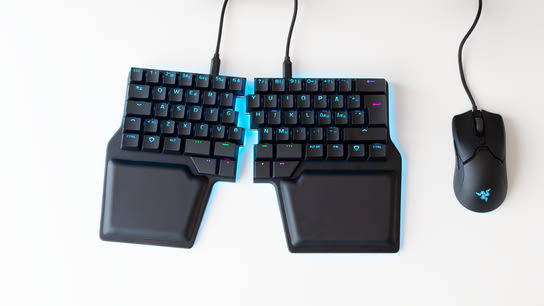Split keyboards can offer greater flexibility and variety for your working posture and desktop arrangements. I’m talking about both wave keyboards that bend upward in the middle (typically branded as “ergonomic keyboards”) and keyboards that can literally split in two. However, you better agree with its designers on how to best use a keyboard.
Dygma Labs sent me one of its Dygma Raise split mechanical keyboards (full review). It’s a 64 % keyboard that can optionally be split down the middle, creating two single-hand keyboard surfaces. A 64 % keyboard is a variation on the more standard 60 % keyboard (no function keys, navigation keys, or a numpad) featuring some non-standard extra keys. The Raise has split the space bar into four keys and has also included four extra “thumb buttons” below those keys. You can position the two halves as you want to suit your needs.
As discussed in my keyboard sizing guide, a wider keyboard setup is best suited for people with broad shoulders. It may be more comfortable to split the keyboard to increase the distance resting position distance between your arms. However, the same wider setup may be uncomfortable for someone with narrow shoulders. People are different and so should our keyboards be.
Split keyboards might also be a suitable alternative for gamers — regardless of their body type — who might not need the right half of their keyboards. Many games are optimized for the right-hand holding the mouse and the left hand resting on the WASD keys. The WASD keys are used as arrow keys to move either the camera or a character around. They’re preferable to the actual arrow keys as they have more keys that can be used as hotkeys in the immediate vicinity. Few games bind common actions to keys on the right side of the keyboard. Getting rid of the left half of the keyboard leaves more room for better postures and for working with the mouse.
Split keyboards, including the Dygma Raise, are often marketed as explicitly being more ergonomic than your typical keyboards. That might be the case for some people. However, there’s a big limitation with these keyboards; and that’s the big old question: “where’s the middle of the keyboard?”
Keyboards are always split along the hand-separation rules commonly used with the touch-typing (“blind typing”) method. When typing with the touch-typing method, you’re not supposed to move your hands off their resting position. From each hand’s resting position, each finger can reach a couple of keys with a minimal amount of movement.
Split keyboards enforce the rules of the touch-typing method by design. There’s some leeway to make adaptations within each hand’s key responsibilities, but you’re out of luck if those adaptations cross the split keyboard divide.
Your left index finger should handle the B key and the right index finger should handle the Y key. However, which finger handles which key is an arbitrary decision. You may have been taught a different style or just prefer it the other way around.
I’ve got reduced mobility in my right index finger and compensate for it by using my left index finger to press both the B and Y keys. I ripped open my finger on a rusty nail while tossing planks into a lake. Childhood activities can be dangerous, kids! The scar looks amazing, but I can’t fully extend my finger during the chilly winter months. It’s never a problem when I use a regular keyboard, so I never think of it as a disability.
Stiffness and reduced finger mobility can also be caused by any number of conditions. People who suffer from finger arthritis are fortunate if it only affects one finger.
The design of split keyboards imposes an accessibility barrier that isn’t there with regular keyboards. The touch-typing method is meant as a best practice for reducing hand strain and not as a hard requirement. Split keyboards assume you’re using the touch-typing method and have a set of fully functional fingers on both hands.
For something to be truly ergonomic, it needs to be adjustable and adaptable to fit different people and needs. Split keyboards could be made more accessible in one of two ways:
They could duplicate the B and Y keys on both halves. This is impractical on something like the Dygma Raise that can be put together to form a regular keyboard. However, it’s a solid option for permanently split or wavy keyboards.
Alternatively, the B and Y keys could be made detachable and movable between the two sides. This design would clearly be more expensive, but it would also make split keyboards usable by more people.
Before you purchase a split keyboard; you should be conscious about how you type, and which fingers perform different tasks around the keyboard.
